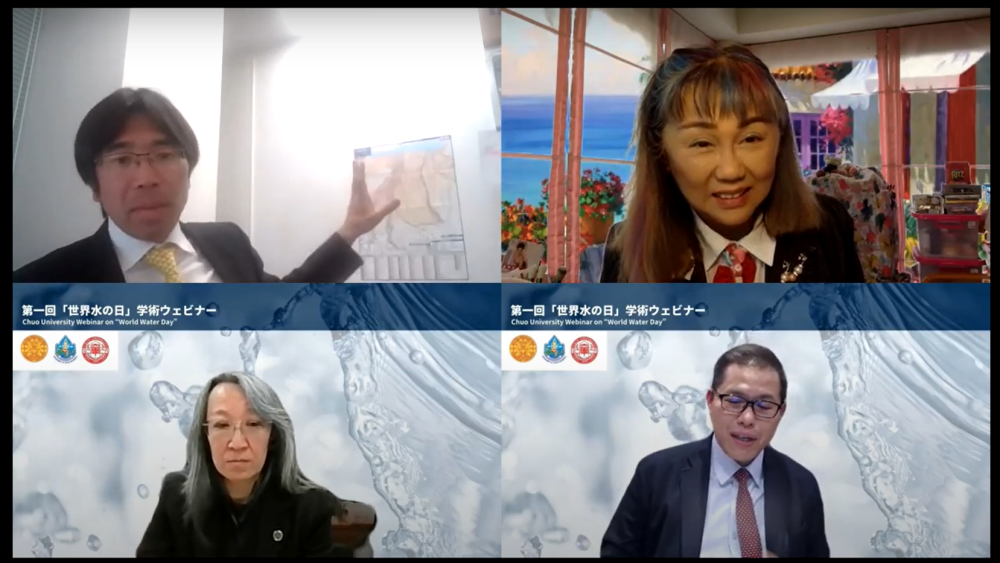2022.05.25
News
World Water Day Academic Webinar on “Regional Diversity of River Environments” held on World Water Day, 22nd March, 2022
Date & Time
March 22, 2022
15:00-17:00 JST
Venue
Online (Simultaneous interpretation in English and Japanese)
Organizer
Institute of Science and Engineering/Chuo University Research Promotion Office, Chuo University, Japan
Co-organizer
Faculty of Engineering, Thammasat University, Thailand
Department of Water Resources, Ministry of Natural Resources and Environment, Thailand
Topic
“Regional Diversity of River Environment”
Program
Opening Remarks: Prof. Toshinari Kamakura
Dr. Supapap Patsinghasanee, Director (Water Operation Center, Department of Water Resources, Ministry of Natural Resources and Environment, Thailand)
”Water Resources Management in Rainfed Agriculture – The Context of Water Crisis in Thailand."
Prof. Uruya Weesakul (Faculty of Engineering, Thammasat University)
“Interpretation of Drought Indicators and Development of Drought Forecasting Model in Thailand for Rainfed Agricultural Area”
Prof. Taichi Tebakari (Faculty of Science and Engineering, Chuo University)
”Major Turning Point of Flood Management Policy in Japan”
Discussion
Moderator: Prof. Hiroko Kudo (Faculty of Law, Chuo University),
Commentator: Prof. Tadashi Yamada (Research and Development Initiative, Chuo University)
Highlights
" Water Resources Management in Rainfed Agriculture – The Context of Water Crisis in Thailand," the first presenter, Director Supapap Patsinghasanee (Department of Water Resources, Ministry of Natural Resources and Environment), reviewed general information on water resources in the country, which are in two seasons: rainy and dry season. Because most rainfed agriculture, which accounts for 78% of the agricultural area, relies primarily on seasonal precipitation as its main source of water, it is subject to climate uncertainty and has a significant impact on the food availability of the poor in developing countries. Warning and forecasting systems are being implemented for water crisis management, but the democratization of hydrologic environmental observations and data is key to success, and in rural areas where monitoring systems are not yet in place, mobile applications are being developed to enable citizens to take on the responsibility of maintaining stations and monitoring data. He also introduced the status of cooperation among ministries in disaster prevention and mitigation measures, including an early warning and forecasting system by the Ministry of Natural Resources and Environment.
Prof. Uruya Weesakul (Faculty of Engineering, Thammasat University), reported under the title of "Interpretation of Drought Indicators and Development of Drought Forecasting Model in Thailand for Rainfed Agricultural Area". She showed the results of her research on the interpretation of drought conditions by the digital values of the Standardized Precipitation Index (SPI) and field observations, understanding of agricultural drought using remote sensing data, and the development of a drought forecasting model using SPI as a drought indicator using artificial intelligence.
Professor Taichi Tebakari (Faculty of Science and Engineering, Chuo University), in his report titled "Major Turning Point of Flood Management Policy in Japan," presented the situation of widespread river flooding damage caused by the 2015 Kinugawa River levee break and Typhoon No. 19 in 2019, and introduced that the Japanese government's Council on Social Infrastructure Development had conducted a study and compiled a report titled "Water Disaster Countermeasures in Light of Climate Change: Shift to Sustainable 'Basin Flood Control' to be Performed by All Parties on a Basin-wide Basis”. In light of recent social changes, there is a need to convert to measures involving all participants, including multi-stakeholder groups such as the national government, prefectures, municipalities, private companies, and residents, and to measures at all locations in the watershed, including not only rivers and flood plains but also catchment areas. For a sustainable future, along with the integration of urban management and flood management policies, the importance of clarifying and improving the accuracy of elemental technologies, improving the accuracy of rainfall forecasting, and optimizing the storage effects of paddy fields and reservoir operations was pointed out.
A lively discussion followed, with Professor Hiroko Kudo serving as moderator and Professor Tadashi Yamada as commentator, and questions from the webinar participants. What efforts are required to implement the reported research results in society? In response to this question, the key concepts presented by each speaker were diversity, sustainability, and inclusiveness. Sustainability in water resource management in Thailand's diverse rural communities is ensured by using a simple, low-cost method in which local residents photograph reservoirs with their smartphones and send the images to authorities. In addition, the application of new systems in rural areas with aging and declining populations requires synchronization with existing systems, which must be safe, simple, and easy to use. The importance was also pointed out in the viewpoint that water use should be optimized by promoting crop diversification and maximizing resource use, as well as the use of IoT in water resource management and empowering rural women and other people through education and technology.
The webinar was concluded by emphasizing the importance of considering technology for the people living in each region in the diversity of the world, based on the characteristics of each region.
please contact: chuo-rpo-intl-grp@g.chuo-u.ac.jp
International collaboration, Research Support Office

